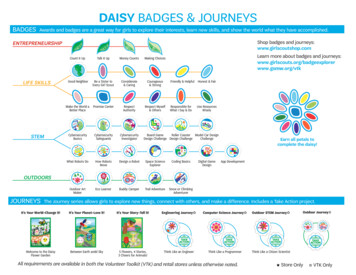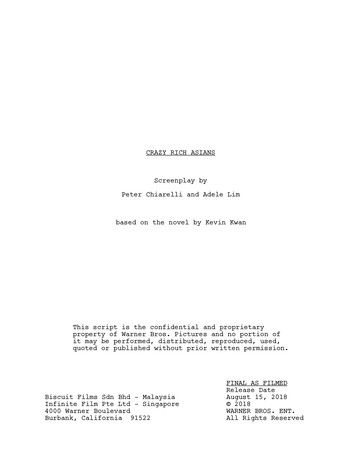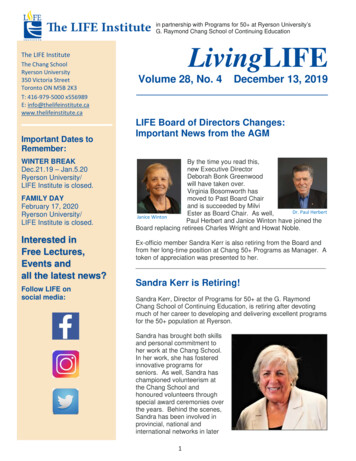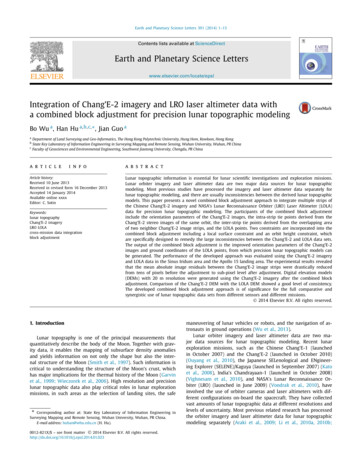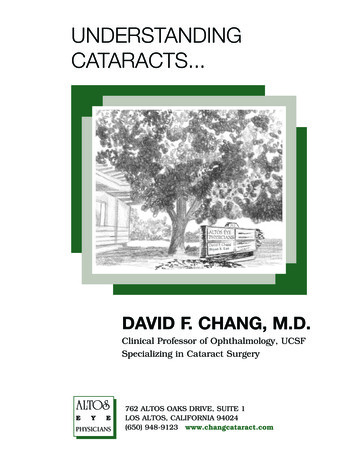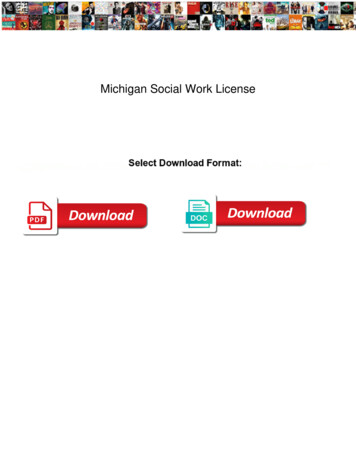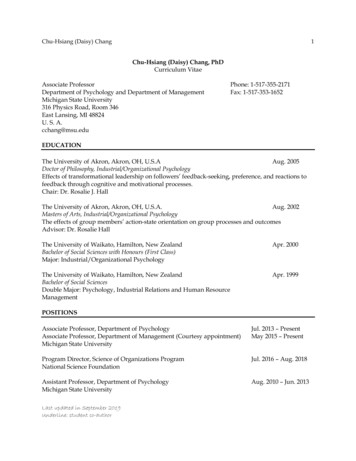
Transcription
Chu-Hsiang (Daisy) Chang1Chu-Hsiang (Daisy) Chang, PhDCurriculum VitaeAssociate ProfessorDepartment of Psychology and Department of ManagementMichigan State University316 Physics Road, Room 346East Lansing, MI 48824U. S. A.cchang@msu.eduPhone: 1-517-355-2171Fax: 1-517-353-1652EDUCATIONThe University of Akron, Akron, OH, U.S.AAug. 2005Doctor of Philosophy, Industrial/Organizational PsychologyEffects of transformational leadership on followers’ feedback-seeking, preference, and reactions tofeedback through cognitive and motivational processes.Chair: Dr. Rosalie J. HallThe University of Akron, Akron, OH, U.S.A.Aug. 2002Masters of Arts, Industrial/Organizational PsychologyThe effects of group members’ action-state orientation on group processes and outcomesAdvisor: Dr. Rosalie HallThe University of Waikato, Hamilton, New ZealandBachelor of Social Sciences with Honours (First Class)Major: Industrial/Organizational PsychologyApr. 2000The University of Waikato, Hamilton, New ZealandBachelor of Social SciencesDouble Major: Psychology, Industrial Relations and Human ResourceManagementApr. 1999POSITIONSAssociate Professor, Department of PsychologyAssociate Professor, Department of Management (Courtesy appointment)Michigan State UniversityJul. 2013 – PresentMay 2015 – PresentProgram Director, Science of Organizations ProgramNational Science FoundationJul. 2016 – Aug. 2018Assistant Professor, Department of PsychologyMichigan State UniversityAug. 2010 – Jun. 2013Last updated in September 2019Underline: student co-author
Chu-Hsiang (Daisy) Chang2Assistant Professor, Department of Environmental & Occupational HealthUniversity of South FloridaJun. 2007 – Aug. 2010Assistant Professor, Department of PsychologyRoosevelt UniversityAug. 2005 – May 2007SIGNIFICANT PROFESSIONAL ACTIVITIES Associate Editor, Journal of Applied Psychology, Sep. 2015 – presento Serving as the Associate Editor for Journal of Applied Psychology (Impact Factor: 5.067)o Overseeing the review and decision-making process for 70 initially-submittedmanuscripts, plus 15 revised-and-resubmitted manuscripts annuallyo Represented the journal at paper development workshops and reviewer trainingsessions at major international conferencesProgram Director, Science of Organizations, National Science Foundation, Jul. 2016 – Aug. 2018o Served as the Program Director of the Science of Organizations program at NationalScience Foundationo Managed the annual program budget of 2.5 - 3 milliono Oversaw the review processes of 70 proposals submitted to the program and othercross-directorate NSF-wide initiatives annuallyo Conducted outreach activities and presentations to broaden participation and promotesubmission at non-research-one universitiesConference Committee Chair, Society for Industrial and Organizational Psychology, Apr. 2016 –Apr. 2018o Led the Conference Committee, which consisted of 7 subcommittees (Program,Workshop, Consortia, Placement, Local Arrangement, Volunteers, Site Selection), forplanning the 32nd (April 2017) and 33rd (April 2018) Annual Conference of the Society forIndustrial and Organizational Psychologyo The 33rd Annual Conference in 2018 was a record-setting meeting for the most-attendedconference.o Both conferences attracted 4900 attendees, and had 1.5 million budget.o Coordinated with the Executive Director and other staff members at the AdministrativeOffice of the Society for Industrial and Organizational Psychology for conferenceplanning activitieso Collaborated with the President of the Society for Industrial and OrganizationalPsychology to select, invite, and secure the Keynote Speakers for the conferencesStudy section member, National Institute for Occupational Safety and Health, Sep. 2015 – Jun.2019o Appointed to be a member of the Study Section for reviewing proposals submitted forextra- and intra-mural funding opportunitieso Membership was approved by the U.S. Department of Health and Human Serviceso Reviewed an average of 6-7 proposals per submission cycle, three cycles per yearLast updated in September 2019Underline: student co-author
Chu-Hsiang (Daisy) Chang3RESEARCH SUPPORTFunded Projects11. FW-HTF-RL: Preparing the future workforce for the era of automated vehicles (WEAVE). NationalScience Foundation. (Sep. 2019 – Aug. 2023). Status: Funded (amount 2,499,999). PI: S.Cotton; Co-PI: C.-H. Chang.10. Narcissism and response distortion in a personality assessment. ACT. (Jan. 2017 – Dec. 2017). Status:Funded (amount 16,500). PI: C.-H. Chang, Co-PI: R. E. Johnson.9. Team cohesion monitoring badge: Development of galvanic skin resistance modality. NationalAeronautics and Space Administration Human Research Program. (Sep. 2015 – Aug. 2016).Status: Funded (amount 100,000). PI: S. W. J. Kozlowski; Co-I: C.-H. Chang.8. Monitoring and regulating teamwork. National Aeronautics and Space Administration HumanResearch Program. (Sep. 2013 – Aug. 2018). Status: Funded (amount 1,199,851). PI: S. W. J.Kozlowski; Co-I: C.-H. Chang.7. Workplace stressors and treatment adherence among type II diabetic employees. Department ofPsychology collaborative research project fund. (May 2012 – May 2013). Status: Funded( 4700). PI: C.-H. Chang; Co-PI: K. Rosenman & V. Gossain.6. Monitoring and regulating teamwork. National Aeronautics and Space Administration HumanResearch Program Omnibus Opportunity. (Sep. 2012 – Aug. 2013). Status: Funded (amount 100,000). PI: S. W. J. Kozlowski; Co-PI: C.-H. Chang.5. Alleviating combat-related stress with adventure training. Pilot Project Grant for Sunshine Educationand Research Center, University of South Florida (Oct. 2009 – Jun. 2010). Status: Funded( 15,000). PI: N. Hall; Co-PI: C.-H. Chang.4. Job experiences in nursing homes. Pilot Project Grant for Sunshine Education and Research Center,University of South Florida (Oct. 2009 – Jun. 2010). Status: Funded ( 14,994). PI: C.VandeWeerd; Co-PI: C.-H. Chang.3. Assessment of exposure to physical and nonphysical violence in physical therapy. R03 research grant forNational Institute for Occupational Safety and Health (1 R03 OH009493-01A1), Center forDisease Control and Prevention (Oct. 2009 – Aug. 2012). Status: Funded ( 140,422). PI: C.-H.Chang.2. Understanding the mechanisms underlying the links between psychosocial factors and work-relatedmusculoskeletal complaints. Pilot Project Grant for Sunshine Education and Research Center,University of South Florida (Jan. 2009 – Jun. 2010). Status: Funded ( 11,340). PI: C.-H.Chang.1. Development and validation of work-based regulatory focus scale. Summer research support grant,Roosevelt University (May 2006 – Aug 2006). Status: Funded ( 1800). PI: C.-H. Chang.Projects under Review1. Recruit and maintain/upgrade a high-tech workforce for emerging technologies. Proposal submitted to theMichigan Department of Transportation. Subaward PI: S. Cotton; Subaward Co-PI: Chang.2. Perceptions of workplace violence prevention legislation among health care administrators. Proposalsubmitted to Michigan Public Policy Research. PI: Arnetz; Co-I: Chang.Last updated in September 2019Underline: student co-author
Chu-Hsiang (Daisy) Chang4BOOKSchonfeld, I. S. & Chang, C.-H. (2017). Occupational health psychology: Work, stress, and health. NewYork: Springer.PEER-REVIEWED PUBLICATIONS50. Chang, C.-H., Yang, L., & Lauricella, T. C. (in press). Social support exchange and nurses’musculoskeletal injuries in a team context: Anger as a mediator. Work and Occupations. DOI:10.1177/073088841982662249. Mao, C., Chang, C.-H., Johnson, R. E., & Sun, J. (2019). Incivility and employee performance,citizenship, and counterproductive work behaviors: Implications of the social context.Journal of Occupational Health Psychology, 24, 213-227. DOI: 10.1037/ocp000010848. Arnetz, J. E., Sudan, S., Fitzpatrick, L., Cotten, S. R., Jodoin, C., Chang, C.-H., & Arnetz, B. B.(2019). Organizational determinants of bullying and work disengagement among hospitalnurses. Journal of Advanced Nursing, 75, 1129-1238. DOI: 10.1111/jan.1391547. Arnetz, J. E., Fitzpatrick, L., Cotten, S. R., Jodoin, C., & Chang, C.-H. (2019). Workplace bullyingamong nurses: Developing a model for intervention. Violence and Victims, 34, 346-362. DOI:10.1891/0886-6708.VV-D-17-0021146. Lee, H., Bradburn, J., Johnson, R. E., Lin, S.-H., & Chang, C.-H. (2019). The benefits of receivinggratitude for helpers: A daily investigation of proactive and reactive helping at work. Journalof Applied Psychology, 104, 197-213. DOI: 10.1037/apl000034645. Golubovich, J., Mak, S., & Chang, C.-H. (2019). Examining physical therapists' training andintervention needs around workplace violence. International Journal of Healthcare Management,12, 40-47. DOI: 10.1080/20479700.2017.137136844. Johnson, R. C., Eatough, E. M., Chang, C.-H., Hammer, L., & Truxillo, D. (2019). Home is wherethe mind is: Family interference with work and safety performance in two high riskindustries. Journal of Vocational Behavior, 110, 117-130. DOI: 10.1016/j.jvb.2018.10.01243. Dudzik, B., Broekens, Neerincs, M., Olenick, J., Chang, C.-H., Kozlowski, S. W. J., & Hung, H.(2018). Discovering digital representations for remembered episodes from lifelog data.MCPMD ’18 Proceedings of the Workshop on Modeling Cognitive Processes from Multimodal DataArticle No. 13.42. Eatough, E. M. & Chang, C.-H. (2018). Effective coping with supervisor conflict depends oncontrol: Implications for work strains. Journal of Occupational Health Psychology, 23, 537-552.DOI: 10.1037/ocp000010941. Zhang, Y., Olenick, J., Chang, C.-H., Kozlowski, S. W. J., & Hung, H. (2018). The I in team:Mining personal social interaction routine with topic models from long-term team data.Proceedings of the 23rd International Conference on Intelligent User Interfaces, 421-426.40. Zhang, Y., Olenick, J., Chang, C.-H., Kozlowski, S. W. J., & Hung, H. (2018). TeamSense:Assessing personal affect and group cohesion in small teams through dyadic interaction andbehavior analysis with wearable sensors. Proceedings of the Association of Computing Machineryon Interactive, Mobile. Wearable and Ubiquitous Technologies, 2(3), Article 150 (September 2018),22 pages. DOI: 10.1145/3264960Last updated in September 2019Underline: student co-author
Chu-Hsiang (Daisy) Chang539. Golden, S. J., Chang, C.-H., & Kozlowski, S. J. W. (2018). Teams in isolated, confined, andextreme (ICE) environments: Review and integration. Journal of Organizational Behavior, 39,701-715. DOI: 10.1002/job.228838. Zhou, L., Wang, M., Chang, C.-H., Liu, S., Zhan, Y. Shi, J. (2017). Commuting stress process andself-regulation at work: Moderating roles of daily task significance, family interference withwork, and commuting means efficacy. Personnel Psychology, 70, 891-922. DOI:10.1111/peps.1221937. Liu, Y., Song, Y., Koopmann, J., Wang, M., Chang, C.-H., & Shi, J. (2017). Eating your feelings?Testing a model of employees’ work-related stressors, sleep quality, and unhealthy eating.Journal of Applied Psychology, 102, 1237-1258. DOI: 10.1037/apl000020936. Chang, C.-H., Bernard, T. E., & Logan, J. (2017). Effects of heat stress on risk perceptions and risktaking. Applied Ergonomics, 62, 150-157. DOI: 10.1016/j.apergo.2017.02.01835. van den Broeck, A., Ferris, D. L., Chang, C.-H., & Rosen, C. C. (2016). A review of selfdetermination theory’s basic psychological needs at work. Journal of Management, 42, 19951229. DOI: 10.1177/014920631663205834. Johnson, R. E., Rosen, C. C., Chang, C.-H., & Lin, S.-H. (2016). Assessing the status of locus ofcontrol as an indicator of core self-evaluations. Personality and Individual Differences, 90, 155162. DOI: 10.1016/j.paid.2015.11.00233. Johnson, R. E., Rosen, C. C., Chang, C.-H., & Lin, S.-H. (2015). Getting to the core of locus ofcontrol: Is it an evaluation of the self or the environment? Journal of Applied Psychology, 100,1568-1578. DOI: 10.1037/apl000001132. Eatough, E. M., Chang, C.-H., & Hall, N. (2015). Getting roped in: Group cohesion, trust, andefficacy following a ropes course intervention. Performance Improvement Quarterly, 28, 65-89.DOI: 10.1002/piq.2118331. Liu, Y., Wang, M., Chang, C.-H., Zhou, L., Shao, R., & Shi, J. (2015). Work-family conflict,emotional exhaustion, and aggression toward others: The moderating roles of workplaceinterpersonal conflict and perceived managerial family support. Journal of Applied Psychology,100, 793-808. DOI: 10.1037/a003838730. Ozer, M. G., Chang, C.-H., & Schaubroeck, J. M. (2014). Contextual moderators of therelationship between organizational citizenship behaviors and challenge and hindrancestress. Journal of Occupational and Organizational Psychology, 87, 557-578. DOI:10.1111/joop.1206329. Golubovich, J., Chang, C.-H., & Eatough, E. M. (2014). Safety climate, hardiness, andmusculoskeletal complaints: A mediated moderation model. Applied Ergonomics, 45, 757-766.DOI: 10.1016/j.apergo.2013.10.00828. Johnson, R. E., Chang, C.-H., Meyer, T., Lanaj, K., & Way, J. D. (2013). Approaching success oravoiding failure? Approach and avoidance motives in the work domain. European Journal ofPersonality, 27, 424-441. DOI: 10.1002/per.188327. Taing, M. U., Smith, T., Singla, N., Johnson, R. E., & Chang, C.-H. (2013). The relationshipbetween learning goal orientation, goal-setting, and performance: A longitudinal study.Journal of Applied Social Psychology, 43, 1668-1675. DOI: 10.1111/jasp.1211926. Koopman, J., Howe, M., Johnson, R. E., Tan, J. A., & Chang, C.-H. (2013). A framework fordeveloping word fragment completion tasks. Human Resource Management Review, 23, 242253. DOI: 10.1016/j.hrmr.2012.12.005Last updated in September 2019Underline: student co-author
Chu-Hsiang (Daisy) Chang625. Ferris, D. L., Johnson, R. E., Rosen, C. C., Chang, C.-H., & Tan, J. A. (2013). When is success notsatisfying? A moderated mediation model of the relation between core self-evaluation andjob satisfaction. Journal of Applied Psychology, 98, 342-353. DOI: 10.1037/a0029776.24. Johnson, R. E., Howe, M., & Chang, C.-H. (2013). The importance of velocity, or why speed maymatter more than distance. Organizational Psychology Review, 3, 62-85. DOI:10.1177/204138661246383623. Rosen, C. C., Slater, D., Chang, C.-H., & Johnson, R. E. (2013). Let’s make a deal: Developmentand validation of the ex post I-Deals scale. Journal of Management, 39, 709-742. DOI:10.1177/0149206310394865.22. Chang, C.-H., Rosen, C. C., Siemieniec, G. M., & Johnson, R. E. (2012). Perceptions oforganizational politics and employee contextual performance: Conscientiousness and selfmonitoring as moderators. Journal of Business and Psychology, 27, 395-406. DOI:10.1007/s10869-012-9257-6.21. Johnson, R. E., Venus, M., Lanaj, K., Mao, C., & Chang, C.-H. (2012). Leader identity as anantecedent of the frequency and consistency of transformational, consideration, and abusiveleadership behaviors. Journal of Applied Psychology, 96, 1262-1272. DOI: 10.1037/a002904320. Yang, L.-Q., Spector, P. E., Chang, C.-H., Gallant-Roman, M., & Powell, J. (2012). Psychosocialprecursors and physical consequences of workplace violence towards nurses: A longitudinalexamination with naturally occurring groups in hospital settings. International Journal ofNursing Studies, 49, 1091-1102. DOI: 10.1016/j.ijnurstu.2012.03.00619. Lanaj, K., Chang, C.-H., & Johnson, R. E. (2012). Regulatory focus and work-related outcomes: Ameta-analysis. Psychological Bulletin, 138, 998-1034. DOI: 10.1037/a002772318. Chang, C.-H., Eatough, E. M., Spector, P. E., & Kessler, S. R. (2012). Violence prevention climate,exposure to violence and aggression, and prevention behavior: A mediation model. Journal ofOrganizational Behavior, 33, 657-677. DOI: 10.1002/job.77617. Johnson, R. E., Rosen, C. C., Chang, C.-H., Djurdjevic, E., & Taing, M. U. (2012).Recommendations for improving the construct clarity of higher-order multidimensionalconstructs. Human Resource Management Review, 22, 62-72.DOI: 10.1016/j.hrmr.2011.11.00616. Eatough, E. M., Way, J. D., & Chang, C.-H. (2012). Understanding the link between psychosocialfactors and work-related musculoskeletal complaints. Applied Ergonomics, 43, 554-563.DOI:10.1016/j.apergo.2011.08.00915. Chang, C.-H., & Lyons, B. J. (2012). Not all aggressions are created equal: A multi-foci approachto workplace aggression. Journal of Occupational Health Psychology, 17, 79-92. DOI:10.1037/a002607314. Chang, C.-H., Ferris, D. L., Johnson, R. E., Rosen, C. C., & Tan, J. A. (2012). Core self-evaluations:A review and evaluation of the literature. Journal of Management, 38, 81-128. DOI:10.1177/014920631141966113. Johnson, R. E., Rosen, C. C., & Chang, C.-H. (2011). To aggregate or not to aggregate: Steps fordeveloping and validating higher-order multidimensional constructs. Journal of Business andPsychology, 26, 241-248. DOI: 10.1007/s10869-011-9238-112. Eatough, E. M., Chang, C-H., Miloslavic, S., & Johnson, R. E. (2011). Relationships of rolestressors with organizational citizenship behavior: A meta-analysis. Journal of AppliedPsychology, 96, 619-632. DOI: 10.1037/a0021887Last updated in September 2019Underline: student co-author
Chu-Hsiang (Daisy) Chang711. Johnson, R. E., Chang, C.-H., & Rosen, C. C. (2010). “Who I am depends on how fairly I’mtreated”: Effects of justice on self-identity and regulatory focus. Journal of Applied SocialPsychology, 12, 3020-3058. DOI: 10.1111/j.1559-1816.2010.00691.x10. Chang, C.-H., & Johnson, R. E. (2010). Not all leader-member exchanges are created equal:Importance of leader relational identity. The Leadership Quarterly, 21, 796-808. DOI:10.1016/j.leaqua.2010.07.0089. Johnson, R. E., Chang, C.-H., & Yang, L.Q. (2010). Commitment and motivation at work: Therelevance of employee identity and regulatory focus. Academy of Management Review, 35, 226245. DOI: 10.5465/AMR.2010.484633328. Chang, C.-H., Johnson, R. E., & Lord, R. G. (2010). Moving beyond discrepancies: The importanceof velocity as a predictor of satisfaction and motivation. Human Performance, 23, 58-80. DOI:10.1080/089592809034002267. Chang, C.-H., Rosen, C. C., & Levy, P. E. (2009). The relationship between perceptions oforganizational politics and employee attitudes, strain, and behavior: A meta-analyticexamination. Academy of Management Journal, 52, 779-801. DOI: 10.5465/AMJ.2009.436708946. Rosen, C. C., Chang, C.-H., Johnson, R. E., & Levy, P. E. (2009). Perceptions of the organizationalcontext and psychological contract breach: Assessing competing perspectives. OrganizationalBehavior and Human Decision Processes, 108, 202-217. DOI: 10.1016/j.obhdp.2008.07.0035. Kessler, S. R., Spector, P. E., Chang, C.-H., & Parr, A. D. (2008). Organizational violence andaggression: Development of the three-factor violence climate survey. Work & Stress, 22, 108124. DOI: 10.1080/026783708021879264. Johnson, R. E., & Chang, C.-H. (2008). Relationships between organizational commitment and itsantecedents: Employee self-concept matters. Journal of Applied Social Psychology, 38, 513-541.DOI: 10.1111/j.1559-1816.2008.00315.x3. Chang, C.-H., Johnson, R. E., & Yang, L. Q. (2007). Emotional strain and organizationalcitizenship behaviors: A meta-analytic review. Work & Stress, 21, 312-332. DOI:10.1080/026783707017581242. Johnson, R. E., Chang, C.-H., & Lord, R. G. (2006). Moving from cognition to behavior: What theresearch says. Psychological Bulletin, 132, 381-415. DOI: 10.1037/0033-2909.132.3.3811. Johnson, R. E., & Chang, C.-H. (2006). “I” is to continuance as “We” is to affective: The relevanceof the self-concept for organizational commitment. Journal of Organizational Behavior, 57, 549570. DOI: 10.1002/job.364BOOK CHAPTERS AND INVITED CONTRIBUTIONS21. Gabriel, A. S., Chang, C.-H., Johnson, R. E., & Rosen, C. C. (2018). So you have tenure: Whatcomes next? The Industrial-Organizational Psychologist, 55(4), 56-58.20. Rosen, C. C., Yochum, E. J., Passantino, L. G., Johnson, R. E., & Chang, C.-H. (2018). Review andrecommended best practices for measuring and modeling organizational citizenshipbehavior. In P. M. Podsakoff, S. B. Mackenzie, & N. P. Podsakoff (Eds.), The Oxford handbookof organizational citizenship behavior (pp. 4081-416). New York: Oxford University Press. DOI:10.1093/oxfordhb/9780190219000.013.4219. Johnson, R. E., Chang, C.-H., Kim, Y., Lin, S.-H. (2018). Employee self-concept and identity. In D.Ones, N. Anderson, H. K. Sinangil, & Viswesvaran, C. (Eds.), Handbook of industrial, work, &Last updated in September 2019Underline: student co-author
Chu-Hsiang (Daisy) Chang8organizational psychology (Vol. 2, 2nd ed.), pp. 25-45. London: Sage. DOI:10.4135/9781473914957.n318. Dixon, A. J., Webb, J. M., Chang, C.-H. (2017). Biosensor approaches to studying leadership. In B.Schyns, P. Neves, & Hall, R. (Eds.), Handbook of methods in leadership research.17. Leong, F. T., Chang, C.-H., & Mak, S., (2017). Occupational Health disparities among AsianAmericans: Review and recommendations. In F. T. Leong, D. Eggerth, C.-H. Chang, M.Flynn, J. K. Ford, & R. Martinez (Eds.) Occupational health disparities: Improving the well-beingof ethnic and racial minority workers (pp. 133-155). Washington, DC: American PsychologicalAssociation.16. Mann, M., & Chang, C.-H. (2016). Work-family issues. S. K. Whitbourne (Ed.), The encyclopedia ofadulthood and aging (pp. 1-5). New York: Wiley-Blackwell.15. Yang, L.-Q., Chang, C.-H., & Lim, V. K. G. (2016). Introduction to the special issue of newmethods in work and organisational health psychology. Applied Psychology: An InternationalReview, 65, 185-189. DOI: 10.1111/apps.1206714. Kozlowski, S. W. J., Chao, G. T., Chang, C.-H., & Fernandez, R. (2015). Team dynamics: Using“big data” to advance the science of team effectiveness. In S. Tonidandel, E. King, & J.Cortina (Eds.), Big data at work: The data science revolution and organizational psychology (pp.272-309). New York: Routledge Academic.13. Santoro, J. M., Dixon, A. J., Chang, C.-H., & Kozlowski, S. W. J. (2015). Measuring andmonitoring the dynamics of team cohesion: Methods, emerging tools, and advancedtechnologies. In E. Salas, W. B. Vessey, & A. X. Estrada (Eds.), Team cohesion: Advances inpsychological theory, methods, and practice (pp. 115-145). Bingley, UK: Emerald GroupPublishing Limited.12. Dixon, A. J., Chang, C.-H., & Johnson, R. E. (2015). Aggression with a conscience: A rational andmoral framework for proactive workplace aggression. In P. L. Perrewé, J. Halbesleben, & C.C., Rosen (Eds.), Research in occupational stress and well being (Volume 12; pp. 81-106). Bingley,UK: Emerald Group Publishing.11. Johnson, R. E., & Chang, C.-H. (2015). Core self-evaluations. In J. D. Wright (Ed.), Internationalencyclopedia of social and behavioral sciences (2nd Edition, pp. 905-910). Oxford, UK: Elsevier.10. Howe, M., Chang, C.-H., & Johnson, R. E. (2013). Understanding affect, stress, and well-beingwithin a self-regulation framework. In P. L. Perrewé, C. C., Rosen, & J. Halbesleben (Eds.),Research in occupational stress and well being (Volume 11, pp. 1-34). Bingley, UK: EmeraldGroup Publishing.***Winner of the 2014 Outstanding Author Contribution Award of Emerald Literati Network***9. Johnson, R. E., Taing, M. U., Chang, C.-H., & Kawamoto, C. K. (2013). A self-regulation approachto person-environment fit. In Kristof-Brown, A. L. & Billsberry, J. (Eds.), Organizational fit:Key issues and new directions (pp. 74-98). Hoboken, NJ: Wiley-Blackwell.8. Chang, C.-H., & Baard, S. K. (2012). Occupational stress in cross-cultural settings: A comparisonbetween North America and East Asia. In P. Genkova, T. Ringeisen, & F. T. L. Leong (Eds.),Handbuch stress und kultur: Interkulturelle und kulturvergleichende perspektiven (Englishequivalent: Handbook stress and culture: Intercultural and cross-cultural perspectives, pp.293-314). Wiesbaden, Germany: VS Publishers, Springer Group.7. Johnson, R. E., Lanaj, K., Tan, J. A., & Chang, C.-H. (2012). Putting our trust in fairness: Justiceand regulatory focus as triggers of trust and cooperation. In L. L. Neider & C. A. SchriesheimLast updated in September 2019Underline: student co-author
Chu-Hsiang (Daisy) Chang9(Eds.), Research in management: Perspectives on justice and trust in organizations (Vol. 9, pp. 128). Hartford, CT: Information Age Publishing.6. Chang, C.-H., & Baard, S. K. (2011). Cross-cultural occupational stress: An individual differencesperspective. In P. L. Perrewé & D. C. Ganster (Eds.), Research in occupational stress and wellbeing (Vol. 9, pp. 265-303). Bingley, UK: Emerald Group Publishing.5. Chang, C.-H., & Spector, P. E. (2011). Cross-cultural occupational health psychology. In J. Quick& L. Tetrick (Eds.), Handbook of Occupational Psychology (2nd Ed., pp. 119-137). Washington,DC: American Psychological Association.4. Rosen, C. C., Chang, C.-H., Djurdjevic, E., & Eatough, E. M. (2010). Occupational stressors and jobperformance: An updated review and recommendations. In P. L. Perrewé & D. C. Ganster(Eds.), Research in occupational stress and well being: New developments in theoretical andconceptual approaches to job stress (Vol. 8, pp. 1-60). Bingley, UK: Emerald Group Publishing.***Winner of the 2011 Outstanding Author Contribution Award of Emerald Literati Network***3. Spector, P. E., & Chang, C.-H. (2009). Social factors in employee health, safety and well-being. InJ. Coreil (Ed.), Social and behavioral foundations of public health (2nd Ed., pp. 401-415). ThousandOaks, CA: Sage.2. Rosen, C. C., Chang, C.-H., & Levy, P. E. (2006). Organizational politics and personality: Past,present, and future. In E. Vigoda-Gadot, & A. Drory, (Eds.), Handbook of organizational politics(pp. 29-52).Cheltenham, UK: Edward Elgar Publishing.1. Doverspike, D., & Chang, C.-H. (2005). Calculating the cost-per-hire. International PublicManagement Association for Human Resources News, June 2005, p. 7-8.CONFERENCE PROCEEDINGS4. Siemieniec, G. M., Chang, C.-H., Rosen, C. C., & Johnson, R. E. (2008). Perceptions oforganizational politics and employee performance: Conscientiousness and self-monitoringas moderators. Abstract published in the conference proceeding of the 2008 SouthernManagement Association Meeting. St Pete Beach, FL.3. Chang, C.-H., Logan, J. M., & Bernard, T. E. (2008). Effects of heat stress on risk perceptions and risktaking. Abstract published in the conference proceeding of the 2008 National OccupationalInjury Research Symposium, Pittsburgh, PA.2. Chang, C.-H., & Johnson, R. E. (2008). Strain and employee outcomes: Work-based regulatory focias moderators. Abstract published in the conference proceeding of the Work, Stress, andHealth 2008: Health and Safe Work Through Research, Practice, and Partnerships. Washington,DC: American Psychological Association.1. Spector, P. E., Kessler, S. R., Chang, C.-H., & Parr, A. D. (2008). Organizational violence climateand exposure to violence and verbal aggression. Abstract published in the conferenceproceeding of the Work, Stress, and Health 2008: Health and Safe Work Through Research,Practice, and Partnerships. Washington, DC: American Psychological Association.WORK UNDER REVISION OR REVIEWJohnson, R. E., Chang, C.-H., Schaubroeck, J. M., & Ott-Holland, C. (revise and resubmit, 1st round).Title removed for blind review.Last updated in September 2019Underline: student co-author
Chu-Hsiang (Daisy) Chang10Kozlowski, S. W. J., DeShon, R. P., Chang, C.-H., Biswas, S., Pearce, M., Braun, M. T., Rench, T. A., &Baard, S. K. (revise and resubmit, 1st round). Title removed for blind review.Chang, C.-H., Eatough, E. M., Ilie, A., Ispas, D., & Johnson, R. E. (under review). Title removed forblind review.PRESENTATIONSRefereed Symposia81. Misisco, A., Olenick, J., Dishop, C., Chang, C.-H., & Kozlowski, S. J. K. (2019, August). Frozenover time? Dynamic equilibrium in ICE teams. In J. Olenick & S. J. K. Kozlowski (Chairs), Amatter of time: Advancing the study of team processes in extreme environments. Symposiumpresented at the 2019 Academy of Management Conference, Boston, MA.80. Johnson, R. E., Lee, H. W., & Chang, C.-H. (2019, August). Organizational citizenship behaviorand its implications for moral licensing. In Y. Song, M. Tu, & J. Koopmann (Chairs),Citizenship behavior: Different theoretical perspectives to understand the predictors and outcomes.Symposium presented at the 2019 Academy of Management Conference, Boston, MA.79. Kozlowski, S. J. K., Chang, C.-H., Biswas, S., Dishop, C., Olenick, J., Morrison, M., & Misisco, A.(2019, August). Capturing the dynamics of team interaction processes. In Collins, C. G. &Quigley, N. (Chairs), Exploration of team dynamics: Advances in theory and methodology.Symposium presented at the 2019 Academy of Management Conference, Boston, MA.78. Chang, C.-H., Johnson, R. E., LeBlanc, C., Kuang, S., Way, J., & Keller, A. (2019, June). Narcissismand response distortion in a personality assessment. In A. N. Stamate (Chair), Employeeselection. Symposium presented at the 19th European Association of Work andOrganizational Psychology Congress, Turin, Italy.77. Dishop, C., Olenick, J., Misisco, A., Morrison, M., Chang, C.-H., & Kozlowski, S. J. K. (2019,April). Issues when combining different data sources. In L. Zhou (Chair), Methodologicaldevelopment in research using organic data: An interdisciplinary view. Symposium presented atthe 34th Society for Industrial and Organizational Psychology Conference, Washington, DC.76. Kozlowski, S. J. K., Chang, C.-H., Dishop, D., Olenick, J., Morrison, M., & Misisco, A. (2019,April). Capturing team process dynamics. In I. Gokhman & L. A. DeChurch, (Chairs), Failureis not an option: Discovering the dynamics of space teams. Symposium presented at the 34thSociety for Industrial and Organizational Psychology Conference, Washington, DC.75. Kozlowski, S. J. K., Chang, C.-H., & Biswas, S. (2019, January). Measuring, monitoring, andregulating teamwork for long duration missions. In K. Reid & L. Landon, (Chairs), Teamadaptation in extreme environment. Symposium present
Summer research support grant, Roosevelt University (May 2006 - Aug 2006). Status: Funded ( 1800). PI: C.-H. Chang Projects under Review 1. Recruit and maintain/upgrade a high-tech workforce for emerging technologies Proposal submitted to the Michigan Department of Transportation. Subaward PI: S. Cotton; Subaward Co-PI: Chang 2.

